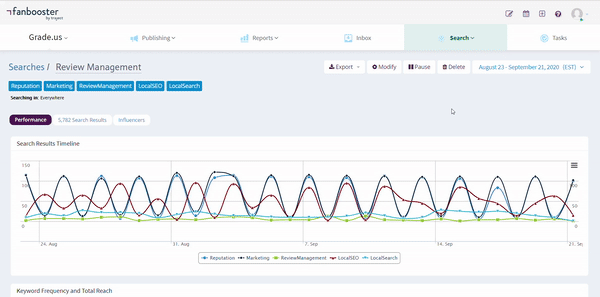Social media can be an incredibly effective marketing tool, but only if implemented and monitored correctly. While most companies have a social media strategy in place, only the businesses that know how to analyze their results will fully benefit from it.
With an estimated 3.6 billion people using social media in 2020, a solid social media marketing strategy is crucial to businesses’ success. Due to its potential impact, it’s no surprise that your clients will want to see concrete reports that show the social media tools and plans you’ve put in place are getting them results.
That’s why we’re sharing eight key social media metrics for you to share with your clients that will illustrate the full effect social media can have on a business.
In this article, you’ll learn:
Table of Contents
Start your free 14-day Fanbooster trial
1. Total Post Reach — Who’s Coming to the Party?
Total post reach is one of the easiest and most effective ways to show clients that the social media strategy you have in place is succeeding.
Total post reach communicates how many unique visitors saw a post. When added up across all posts, this provides a comprehensive overview of how many people have seen your posts — aka the number of individuals who were exposed to the client’s products and services.
When explaining this social media metric to clients, remind them that the broader the reach of a post, the more potential it has to become viral. Show them the posts with the highest number of unique visitors to really solidify the power a single piece of content can have.
2. Click-Through Rate
Click-through rates (CTR) show your client the exact number of people that go from a social media post to your client’s website. Essentially, CTR is one of the most important social media engagement metrics that outlines precisely how much your work boosts their site’s overall traffic.
Measuring your client’s CTR can be challenging, as most social networks don’t natively track this data.
That’s where Fanbooster comes in.

When you share a link using Fanbooster’s UTM codes, we’ll track the number of times it’s clicked with our built-in link shortener. Plus, if you organize your content with Post Presets, you can test different ideas and drafts among various groups to determine the most effective way to drive traffic to your client’s website.

3. Audience Growth Rate — It’s All About the Followers
The audience growth rate shows how many new followers you’ve gained on a given social network. It’s typically tracked month to month and could easily be referred to as the “popularity metric.”
To calculate this statistic, simply divide the number of new followers by the number of existing followers.

For example, if you have 1,000 Twitter followers on June 1, and 1,050 on July 1, your audience growth rate would be 5% (50 / 1000 = 0.05), comparing June to July.
You can also use this formula to measure the total audience growth rate across multiple social media platforms — making it a very powerful tool in determining if one platform performed particularly well one month while others lagged.
To simplify this metric even more, Fanbooster has developed tools that will track growth rates for social media networks and generate single- or cross-channel reports. Using these tools, you can clearly see the total number of social media followers per platform, how many followers you’ve gained, and your total audience growth rate.
4. Shares Per Post, or Amplification Rate
There are two ways to effectively present the amplification rate, which is the number of times your posts are shared by individual users.
The first approach is to add up the total number of shares of all posts for a specific period of time (say, 30 days). While this is an impressive number to share, it lacks specificity in terms of what types of content performed best on which platforms.
In general, it’s best to go with the second approach: Take the total number of shares for all posts and divide it by the number of posts for those 30 days.
Not only is this a more detailed social media metric, it is also a more tangible and feasible number for you to be able to improve over time.
Further break down your data analytics by tracking shares per type of post — for example, shares per video, image, or text-only post. This will help determine the types of content that performs best for your client’s desired audience.
5. Likes Per Post and Applause Rate
These social media marketing metrics are all about the amount of love your posts are getting.
When determining the likes per post rate, you can use the same approaches for calculating shares per post — either track this statistic cumulatively or find an average number of likes per post. The latter is recommended for the most thorough, applicable data.
Tracking the number of likes your posts get lets you know exactly how valuable your audience considers it to be. Basically, if a user enjoys the video you’ve put out into the world, they’ll likely tap that heart or thumbs-up icon to share this sentiment.
Alternatively, some marketers prefer to track a platform’s “applause rate” instead of the number of likes per post. To calculate the applause rate, add up all of the likes a platform’s posts received for a given period of time and divide it by the platform’s number of followers.
As opposed to likes per post, the applause rate shows your client how engaged their entire audience is and proves that you’ve built a legitimate, interested following.
6. Overall Engagement Rate — All of the Above
Want to get a sense of everything: likes, comments, shares, new followers — all of it? That’s where the overall engagement rate comes in.
To calculate the overall engagement rate, add up every single engagement a platform’s posts received in a set period of time and divide that number by its total number of followers.
Providing your client with this statistic shows them exactly how much their audience appreciates and engages with your social media posts.
7. Brand Awareness — What’s the Buzz?
How often a client’s brand is mentioned across all social media platforms is known as brand awareness. This includes direct @mentions, name mentions, branded hashtags, and any other mention of the brand name.
Clients want to know how popular their brand is, and this metric tells them just that. Moreover, it’s a way to keep tabs on what the audience is saying.
Knowing this will help you improve your content, advise your client (say, about new products that are being requested), and ensure that you have your finger on the pulse of your audience’s likes, dislikes, and opinions of the brand.
Because tracking all this can be time consuming and, quite frankly, overwhelming, Fanbooster offers a social listening feature that does the work for you.

In addition to automatically tracking multiple keywords across every social media network associated with your client, the social listening tool also automates the search process and provides you with up-to-date, comprehensive results.
8. Conversion Tracking
The most important social media metric you can track for a client is the amount of sales or other tangible engagements driven by your posts. This is called conversion tracking, or keeping tabs on the number of people that click on a post and then “convert” to a paying customer.
Calculating conversion rate is fairly easy — divide the number of conversions you get in a given time frame by the total number of people who visited the site and multiply it by 100.

For example, if your social media platform had 20,000 visitors and 2,500 conversions in 30 days, the conversion rate is 12.5%.
There’s an even simpler way, though: just add conversion tracking to your Fanbooster Post Presets. By placing a short HTML code on your checkout page, you can record how many people in your Post Presets click on a link and opt to make a purchase. You can even input the cost and value of each conversion.
Tracking your social media ROI (return on investment) in this way allows your clients to see exactly how many sales you’ve generated from your social media posts, further boosting your value to the company.
Final Thoughts: Top 8 Social Media Metrics Sure to Impress Clients
When you present clients with clear social media engagement metrics you can show them the exact impact your social media posts are having across every platform. From how much business your social media strategy drives, to how engaged the audience is with the brand, these social media marketing metrics are invaluable marketing tools to you and the client.



